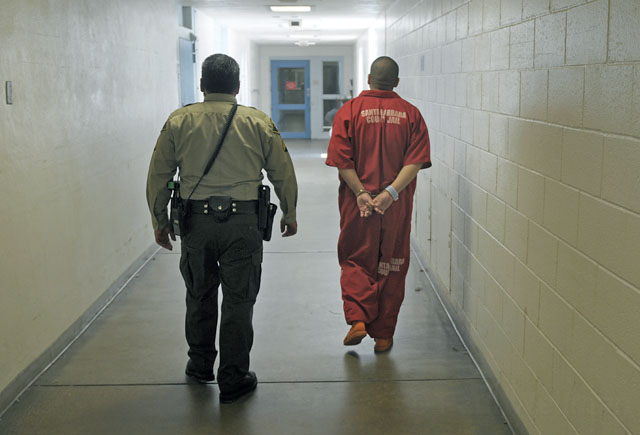Musical Chairs Behind Bars
State and County Continue the AB109 Inmate-Trading Game

The number of people under local supervision after being released from prison is on track with projections following the 2011 statewide shift in incarceration law, but the number of felons sentenced locally continues to be a problem, according to officials.
For decades, the Santa Barbara County Jail has been coping with a maxed-out facility, and it’s been under court order to release select criminals when the jail’s population cap is reached. But now, with the jail housing more people post-conviction under Assembly Bill 109, officials are trying to get creative. “Obviously, we struggle with that every day,” said Sheriff’s Commander Laz Salinas. “With AB 109, it makes it more of a challenge.”
Under realignment, the county is now responsible for two groups of people who previously would’ve been overseen by state officials: inmates who served their prison sentences for nonserious, nonviolent, or nonsexual offenses are supervised by County Probation rather than state parole, while certain low-level felony convicts are now serving their prison time in local jails.
The legislation was passed in response to California’s bursting-at-the-seams prison system and has significantly lowered the number of inmates in prison. There has been an emphasis on evidence-based programs that discourage recidivism.
And now, with the implementation of programs in response to AB 109, officials are beginning to hone in on effective tools. Staffing in different areas around the county — like a DA for substance abuse treatment court, an AB 109 mental health clinic, and a psychiatrist at the probation resource centers — are enhancing opportunities for success, said Probation Chief Beverly Taylor this week at the Board of Supervisors meeting. “We’re making good progress.” Indeed, Santa Barbara officials have been lauded for their preparation and reaction to realignment.
As of April, there were 329 people who had been released from prison and were being supervised by local officials, including 128 from the City of Santa Barbara. Of those, 77 percent were considered high risk. From October 2011 through the end of 2012 in Santa Barbara County, 18 percent were convicted of a new felony during their term of supervision. The state average is 35 percent.
In the first year, 165 people were sentenced straight to a jail when in the past they would have gone to prison. Of those, 24 were transferred to electronic monitoring. Now, those serving felony sentences locally total 142 as of April 2013. Of those, more than 54 percent are considered a high risk for recidivism and violence.
While previously a jail stay could be measured in weeks or months, the average stay in County Jail is now two to three years, Salinas said. Split-sentence inmates average two years in jail along with two to three years under Probation’s supervision. Part of the reason for the increase in split sentences, according to Salinas, is that judges recognize their importance. The inmates with straight sentences have no incentives or programs to help them find jobs or get treatment; they just serve their time and leave. “The chances of them reoffending are very high,” he said.
A report released last week by the Department of Corrections says that one-year arrest rates are down, and conviction rates are steady for post-release. Post–AB 109 offenders were arrested at a 58.7 percent rate, according to the study, while pre-realignment offenders were arrested at a 62 percent rate. The percentage of post-realignment offenders convicted of new crimes is slightly higher than those pre-realignment, according to the report.
Former lieutenant governor Abel Maldonado, who failed in an election contest last year against Representative Lois Capps but is now likely running for governor, has been touring the state, highlighting instances of people who should be in prison but are instead out and committing crimes because of AB 109. “People don’t realize what realignment really means,” Maldonado said. “It’s just a fancy name for early release.” State officials, however, say calling realignment “early release” is inaccurate.
Here in Santa Barbara, there is one inmate serving a 23-year prison sentence in County Jail. Another, who was placed on electronic monitoring instead of jail (which was already a substitute for a prison sentence), cut off his monitoring unit and left the state; he then returned and was ultimately arrested.
Maldonado said that in Santa Maria there were five burglaries in February 2012. That number jumped to 50 in February 2013, he said, connecting the dots to AB 109. To that end, Maldonado, who at one time was mayor of Santa Maria before going on to the State Legislature, said he is in the midst of drafting a ballot measure to repeal AB 109. He plans to gather signatures and mount a campaign for the 2014 election.



